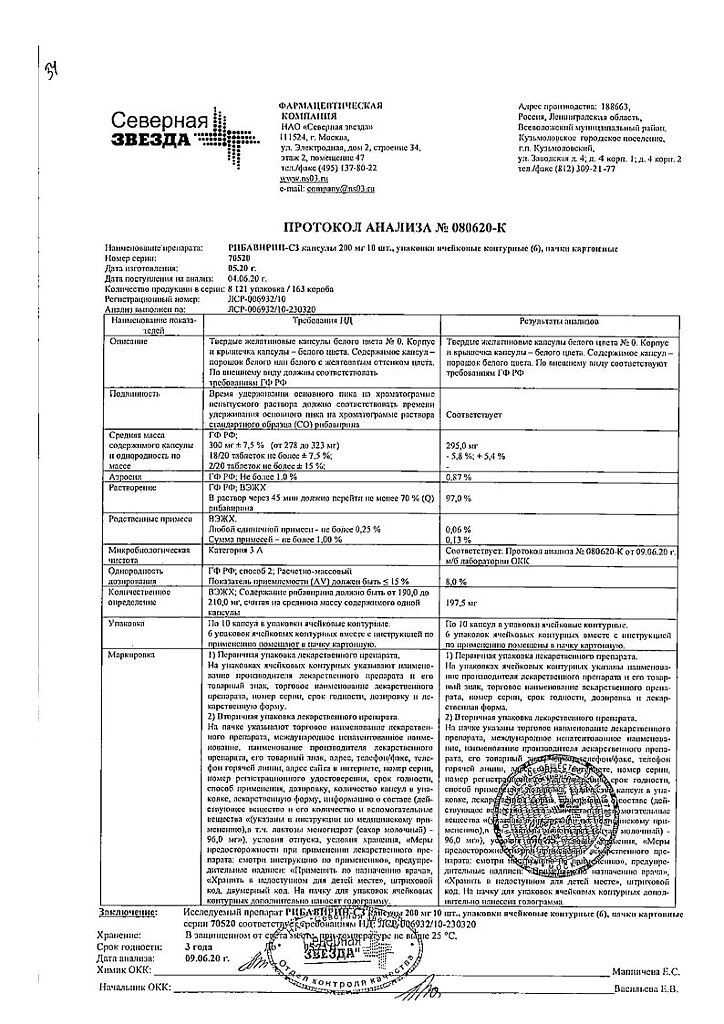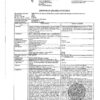No products in the cart.
Description
Ribavirin is a synthetic nucleoside analogue with a pronounced antiviral effect. It has a wide spectrum of activity against various DNA and RNA viruses.
Pharmacodynamics.
Ribavirin easily penetrates into virus-infected cells and is quickly phosphorylated by intracellular adenosine kinase into ribavirin mono-, di- and triphosphate. These metabolites, especially ribavirin triphosphate, have marked antiviral activity. The mechanism of action of ribavirin is not well elucidated. However, it is known that ribavirin inhibits inosine monophosphate dehydrogenase (IMF), this effect leads to a marked decrease in intracellular guanosine triphosphate (GTP) levels, which, in turn, is accompanied by suppression of synthesis of viral RNA and virus-specific proteins. Ribavirin inhibits replication of new virions, which ensures reduction of viral load. Ribavirin selectively inhibits viral RNA synthesis without suppressing RNA synthesis in normally functioning cells. Ribavirin is effective against many DNA and RNA viruses.The most sensitive DNA viruses to ribavirin are: Simplex herpes virus, poks-virus, virus of Marek¢s illness. Ribavirin-insensitive DNA viruses are: Varicella Zoster, pseudorabies, cow smallpox. The most ribavirin-sensitive RNA viruses are: influenza A, B, paramyxovirus (parainfluenza, epidemic raorotite, Nucasl¢s illness), reoviruses, RNA tumoral viruses. RNA tumor viruses insensitive to ribavirin are: enteroviruses, rhinovirus, Semlicy Forest. Ribavirin has activity against hepatitis C virus (HCV). The mechanism of action of ribavirin against HCV is not fully elucidated. It is assumed that ribavirin triphosphate, which accumulates with phosphorylation, competitively suppresses guanosine triphosphate formation, thereby reducing viral RNA synthesis. It is also believed that the mechanism of synergistic action of ribavirin and interferon alpha against HCV is due to increased phosphorylation of ribavirin by interferon.
Pharmacokinetics.
– Absorption: when administered orally, ribavirin is rapidly absorbed in the gastrointestinal tract. Its bioavailability is more than 45%. Distribution: ribavirin is distributed in plasma, respiratory tract mucosal secretion and erythrocytes. A large amount of ribavirin triphosphate accumulates in erythrocytes, reaching a plateau by day 4 and persisting for several weeks after administration. The half-life is 3.7 h. The volume of distribution (Vd) is 647 – 802 l. When administered during a course of treatment, ribavirin accumulates in the plasma in large amounts. The ratio of bioavailability indices (AUC – area under the curve “concentration/time”) in repeated and single administration is 6. Significant concentration of ribavirin (over 67%) can be detected in cerebrospinal fluid after long-term use. It is insignificantly bound to plasma proteins. Time to reach maximum plasma concentration is 1 to 1.5 hours. The time to reach therapeutic plasma concentrations depends on the minute blood volume. Mean values of maximum concentration (Cmax) in plasma: about 5 µmol per liter at the end of 1st week of administration in dose of 200 mg every 8 hours and about 11 µmol per liter at the end of 1st week of administration in dose of 400 mg every 8 hours.
– Biotransformation: ribavirin is phosphorylated in liver cells into active metabolites as mono-, di- and triphosphate, which are then metabolized to 1,2,4 – triazolecarboxamide (amide hydrolysis to tricarboxylic acid and deribosylation to form a triazole carboxyl metabolite).
– Excretion: Ribavirin is slowly excreted from the body. Elimination half-life (T1/2) after a single dose of 200 mg is 1 to 2 hours from plasma and up to 40 days from erythrocytes. After discontinuation of a course of administration, T1/2 is about 300 hours. Ribavirin and its metabolites are excreted mainly by the kidneys. Only about 10% are excreted through the intestine. About 7% of ribavirin is eliminated unchanged after 24 hours and about 10% after 48 hours. Pharmacokinetics in special clinical conditions: In patients with renal failure the AUC and Cmax of ribavirin are increased due to decreased true clearance. Pharmacokinetics of ribavirin does not change in patients with hepatic insufficiency (A, B and C degree). Ribavirin pharmacokinetics changes significantly after a single dose with fat containing food (AUC and Cmax increase by 70%).
Indications
Indications
Chronic hepatitis C (in combination with interferon alfa-2b or peginterferon alfa-2b): In primary patients not previously treated with interferon alfa-2b or peginterferon alfa-2b; in exacerbations after monotherapy with interferon alfa-2b or peginterferon alfa-2b; in patients unresponsive to monotherapy with interferon alfa-2b or peginterferon alfa-2b.
.
Active ingredient
Active ingredient
Composition
Composition
Active substance: ribavirin – 200 mg.
Excipients: lactose (milk sugar), colloidal silica (aerosil), magnesium stearate. Solid gelatin capsules â 0: gelatin; purified water; colorant: titanium dioxide.
Description: Capsules of white color â 0. The contents of capsules – powder of white or white with a yellowish tint. Pharmacotherapeutic group: antiviral.
.
How to take, the dosage
How to take, the dosage
Orally, without chewing and drinking water, along with meals 0.8-1.2 g per day in 2 doses (morning and evening). Simultaneously interferon alfa-2b – subcutaneously, 3 million IU 3 times a week or peginterferon alfa 2b – subcutaneously, 1.5 mcg/kg once a week are prescribed. In combination with interferon alfa-2b in case of body weight less than 75 kg a dose of ribavirin – 1 g per day (0.4 g in the morning and 0.6 g in the evening); above 75 kg – 1.2 g per day (0.6 g in the morning and 0.6 g in the evening). In combination with peginterferon alfa-2b with body weight less than 65 kg a dose of ribavirin – 0.8 g per day (0.4 g in the morning and 0.4 g in the evening); 65-85 kg – 1 g per day (0.4 g in the morning and 0.6 g in the evening); over 85 kg (0.6 g in the morning and 0.6 g in the evening). Duration of treatment is 24 to 48 weeks; with at least 24 weeks for previously untreated patients, and 48 weeks for patients with genotype 1 virus. In patients not susceptible to interferon alfa monotherapy, as well as in case of relapse – at least 6 months to 1 year (depending on the clinical course of the disease and the response to the therapy).
Interaction
Interaction
Medicinal products containing magnesium and aluminum compounds, simethicone decrease the bioavailability of the drug (AUC decreases by 14%, has no clinical significance). In concomitant use with interferon alpha-2b or peginterferon alpha-2b – synergism. Administration of ribavirin during treatment with zidovudine and/or stavudine is accompanied by a decrease in their phosphorylation, which may lead to HIV viremia and require a change in the treatment regimen. Increases the concentration of phosphorylated metabolites of purine nucleosides (including didanosine, abacavir) and the associated risk of lactic acidosis. There is no effect on hepatic enzymatic activity involving cytochrome P450. Simultaneous intake of food with high fat content increases bioavailability of ribavirin (AUC and Cmax are increased by 70%).
Special Instructions
Special Instructions
It is necessary to take into account teratogenicity of the drug, men and women of reproductive age should use effective contraceptives during treatment and within 7 months after termination of therapy. Laboratory tests (clinical blood count with leukocyte formula and platelet count, determination of electrolytes, creatinine, liver function tests) should be performed before the start of therapy, on the 2nd and 4th weeks and then regularly. During ribavirin treatment, maximum decrease of hemoglobin is usually observed after 4 to 8 weeks from the start of treatment. If hemoglobin falls below 110 mg/ml, the dose of ribavirin should be temporarily reduced by 400 mg per day; if hemoglobin falls below 100 mg/ml, the dose should be reduced to 50% of the initial dose. In most cases, the recommended dose changes provide hemoglobin recovery. If hemoglobin decreases below 85 mg/ml, the drug should be discontinued. In acute manifestation of hypersensitivity (urticaria, angioneurotic edema, bronchospasm, anaphylaxis) the drug should be stopped immediately. Transient rashes are not grounds for treatment interruption. During the treatment period, persons who are tired, drowsy or disoriented should refrain from driving motor transport and potentially dangerous activities that require high concentration and quick psychomotor reactions. Due to possible worsening of renal function in elderly patients, renal function, particularly creatinine clearance, should be determined before using the drug.
Contraindications
Contraindications
Side effects
Side effects
CNS and peripheral nervous system disorders: headache, dizziness, general weakness, malaise, insomnia, asthenia, depression, irritability, anxiety, emotional lability, nervousness, agitation, aggressive behavior, confused consciousness; rarely – suicidal tendency, increased smooth muscle tone, tremor, paresthesia, hyperesthesia, hypoesthesia, fainting.
Cardiovascular system: decreased or increased BP, brady or tachycardia, palpitations, cardiac arrest.
Hematopoietic disorders: hemolytic anemia, leukopenia, neutropenia, granulocytopenia, thrombocytopenia; very rarely – aplastic anemia.
Respiratory system disorders: dyspnea, cough, pharyngitis, dyspnea, bronchitis, otitis media, sinusitis, rhinitis.
Digestive system disorders: dry mouth, decreased appetite, nausea, vomiting, diarrhea, abdominal pain, constipation, perversion of taste, pancreatitis, flatulence, stomatitis, glossitis, gum bleeding, hyperbilirubinemia.
Sensory organs: lacrimal gland involvement, conjunctivitis, visual impairment, hearing impairment/loss, tinnitus.
Muscular system disorders: arthralgia, myalgia.
Hyrogenital system disorders: hot flashes, decreased libido, dysmenorrhea, amenorrhea, menorrhagia, prostatitis.
Allergic reactions: skin rash, erythema, urticaria, hyperthermia, angioedema, bronchospasm, anaphylaxis, photosensitization, erythema multiforme, Stevens-Johnson syndrome, toxic epidermal necrolysis; with intravenous administration – chills.
Local reactions: pain at the injection site.
Others: hair loss, alopecia, hair texture disorders, dry skin, hypothyroidism, chest pain, thirst, fungal infection, viral infection (including herpes), flu-like syndrome, sweating, lymphadenopathy. Medical personnel performing inhalation administration may have headache, itching, hyperemia of the eyes or swollen eyelids.
Overdose
Overdose
The severity of side effects may increase. Treatment: drug withdrawal, symptomatic therapy.
Pregnancy use
Pregnancy use
Ribavirin is contraindicated in pregnancy and during lactation (breastfeeding).
Similarities
Similarities
Additional information
| Shelf life | 2 years. Do not use after the expiration date. |
|---|---|
| Conditions of storage | List B. Store in a dry place protected from light at a temperature not exceeding 25°C. Keep out of reach of children. |
| Manufacturer | North Star NAO, Russia |
| Medication form | capsules |
| Brand | North Star NAO |
Related products
Buy Ribavirin-SZ, 200 mg capsules 60 pcs with delivery to USA, UK, Europe and over 120 other countries.












